Anatomy of an Era: Eric Stokes, Part 3
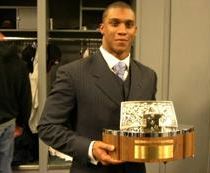
Excerpted from Chapter 66, No Place Like Nebraska: Anatomy of an Era, Vol. 2 by Paul Koch
Anatomy of an Era: Eric Stokes, Part 3
Q: What stands out after that ’94 Florida State/Orange Bowl game where you say things changed? What stands out to you the most?
Eric Stokes: Just the focus that the team had that next year, because we had tremendous leadership. We had Trev Alberts on the team and lost him, and we had Ed Stewart, and Tommie was really coming into his own going into that ’94 year. We just had such a focus and a level of commitment.
And the big part of it, too? With Tommie we just knew he was going to win. One thing about being on the defensive side of the ball looking on the offense, I always felt like the opposing defense was going to have a hard time with our offense. And I think if you talk to the offensive players they’d just say that they always felt the defense was going to stop the other team. Just the amount of confidence and the amount of swagger that we had.
And I truly believe a lot of the wins over those two years? Teams were already defeated before we even kicked off. Really, truthfully, you could see it. Particularly when teams came into Lincoln, they were already 21 points down. You could really see it in their body language. Only a couple teams… Washington State, they came in prepared to play and gave us a run that year. But when you look how that season went from ’94 to ’95 we pretty much breezed through the year. Every game was tough, even when you look at ’94 when Matt Turman started against Kansas State.
You think about that: we had a third-string quarterback who was a walk-on, we really couldn’t throw, Lawrence Phillips was playing with a broken toe and a broken thumb and still carried it 30-some times, and basically we went into the game knowing that Kansas State couldn’t score. We knew the only way to win the game: all the pressure was on the defense. It went hand in hand like that. There were a lot of instances like that. We had that slogan, “We Refuse to Lose,” but that came true, it became a real thing.
The other thing that stood out was when Brook Berringer died, and just kind of the perspective when we went into that next season, that was tough. That was a tough thing.
Q: I don’t mean to rub salt in an old wound, but that Arizona State game in Tempe, was that just a matter of every now and then a good team having an off-week or what?
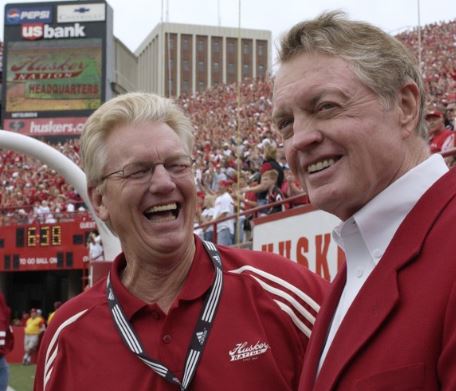
Charlie McBride and Tom Osborne enjoying a game day
ES: I think it was a couple things. One, I think there was a lot of change going on: because at that point we were a very talented team but we had lost Tommie and Brook, Ahman was hurt going into that year, Scott Frost had taken over the offense and was still kind of finding his way. And I’ve gotta give Arizona State credit, that was a pretty good team. They played in the Rose Bowl and lost to Ohio State that year, but that was a better team than what we’d given them credit for. We beat them like 63-7 the year before, so I think a lot of guys had that sense of entitlement, because we had a lot of new guys that were new starters that year and had a little sense of, “Hey, we beat these guys last year. We can walk in there and beat them in no time flat.”
One thing that stood out about that Arizona State game: Charlie McBride warned us all that week. Believe me, there was a message that was preached. The team was really young that year before and they had 20 or 21 starters back from that team and that depth, and then you had that Tempe heat. It was all those things. It was a sucker game for us, because we underestimated them and went into a hostile environment and, at the time, Frost was low on experience and we got tripped up. We got tripped up and they were the better team that night. That’s how I see that game, the reason why we lost it. And then, after that we regained our focus and got better. And that’s how the season went until we ran into Texas.
Q: On the flipside, do you have a favorite game?
ES: For me, the Colorado game my senior year at home. Obviously, the national championship games were big, but that last game in Lincoln against Colorado, a close-knit game and I played pretty well in that game, too, so to go out a winner and play one of the better games in my career to finish it off, that game stands out for me outside of the two national championship games.
Q: Which National Championship game do you probably appreciate more?
ES: Actually, I appreciated the Florida game more, just from a personal standpoint. My sophomore year I played a lot in the championship game against Miami, but I tell you what, I didn’t play very well in that game. In my own estimation, truth be told, I think I got a little bit too caught up in the moment and didn’t play with the type of poise that I should have. It was a big game and I kind of got caught up in it. I didn’t play as well as I should have played.
And then the Florida game, because that was the year I got benched. I had to scrape and claw and was backing up both Minter and Veland and was playing a lot, because both those guys had come off of knee surgeries the year before and they kind of had to work a rotation just to get them through the season. It was a tough year and a year that really challenged me, because I didn’t feel I deserved to get benched a few games into the season. Sometimes as a player you feel like you’re not being treated fairly, and I was definitely not happy with the situation.
And I got into the Florida game and played well and got an interception, and that really gave me momentum going into my senior year, a lot of confidence. It was like, ‘If I can get through that type of season with the benign tumor and surgery and rehab and really fight to get back to playing, it’s like getting to the mountaintop and getting knocked back down and then getting back on top all over again.’ I felt I could make it through anything after that.
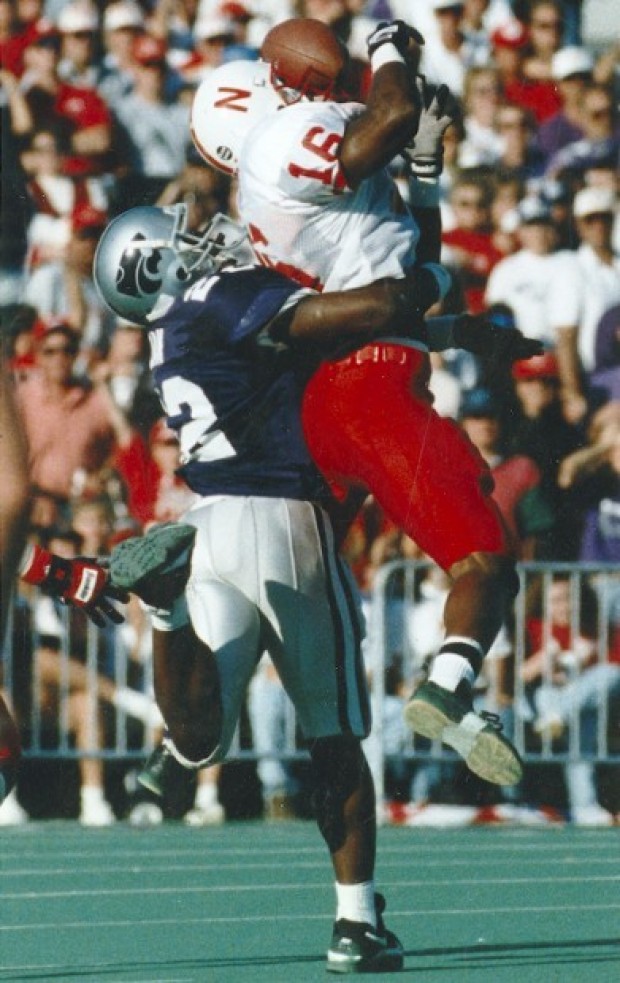
Q: What kind of tumor was this?
ES: I had a benign tumor in my pelvic bone that, actually -I missed spring ball my sophomore year, because I actually fractured my hip and pelvic bone in practice- and that’s how they found it. I was involved in a play where I was making a tackle and you know, you kind of get caught up in the pile-kind of thing, and I ended up in the bottom of it and I felt a ‘pop’ and was kind of in an awkward position. I thought I’d pulled a muscle, and after X-rays found I’d fractured my pelvic bone and hip bone. So I had surgery and was on crutches for 16 weeks and didn’t know if I was going to come back and play. There were doubts as to where I was and where I would be on the depth chart and all that kind of stuff creeps in. But I bounced back and I didn’t miss any time going into the next year.
Q: Did that tumor have anything to do with the break?
ES: Yeah, what it did was, it literally hollowed out the pelvic bone. That’s what caused the break.
Q: I would think the NFL would have been wary of that come draft time…
ES: You know what, it was good. The doctor who had performed the surgery, his name is Dr. Naff -and the irony of this is he actually passed away of cancer a few years ago now, maybe four or five years ago. But he actually treated me and he said that when he did the surgery he was very confident. I don’t think anybody else was all that confident, but he said, “I’ll fix this and your leg will be stronger than your other leg.” To this day I really haven’t had any problems aside from where they had to cut me open to do the bone graft. They cut me open pretty good on my left side, so I don’t have any feeling on my left side, the nerve endings right above my hip bone where they made the cut.
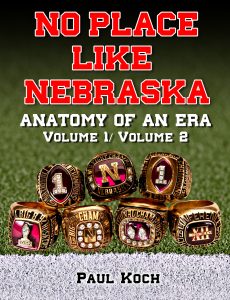
Available on Amazon.com
Q: I think that’s called the iliac arch, if the old anatomy classes come to mind from those undergrad days. So let me ask, what do you think about the ’95 year with Lawrence’s issues and everything going on? Was that a blessing in retrospect?
ES: No, it wasn’t good for the team. But here’s the thing: the leadership was so strong. Coach Osborne handled it and he got criticism for it, but seeing him handle that and seeing him back Lawrence up on every issue, you just knew that he would go to the end of the earth for you. So in retrospect, it strengthened the team, because our coach was taking a beating and the team was taking a beating. We had a lot of incidents that year, with Christian Peter and Terrell Farley, so there was a series of things that went on that year that you think would have been a complete distraction and dragged the team down, but it really strengthened the team.
What I keep going back to is the single-minded focus about winning. And you hear this about teams that get on a run, and what happens is that we happened to have that kind of “us against the world” mentality, and we’d been backed into a corner. And we weren’t going to sit in the corner, we were going to come out fighting. And the only way to prove that was to come out on the field and play for the coaches, so that’s what we did. We played for Coach Osborne. So in some ways it was a blessing in disguise, but unfortunately, it was an unfortunate series of events.
I’ll tell you about Lawrence Philips. We weren’t friends and we weren’t close, but truthfully, that guy was in my opinion the best running back ever to play at Nebraska. Now, he didn’t win the Heisman, but you saw. You saw that guy, he was the real deal. You can throw out the whole ‘NFL bust’ and all that, but talent-wise that guy was an incredible, overall not just a running back, but he was a real football player. He’ll never probably get his just due because of everything that happened, but he is by far and away one of the best players ever to walk through Nebraska. I think if you’ve asked that of other guys you’d hear the same thing.
Q: And is that from a scout’s perspective or a fellow player’s perspective?
ES: That’s from a player’s perspective. I’m just saying that from going against him in practice and seeing what he could do on gamedays. And the most impressive I’ve ever seen him was the Kansas State game when we had Turman start. We couldn’t throw, they knew we couldn’t throw. K-State literally played 9 guys in the box and the guy still literally rushed 30+ times with a broken big toe, turf toe, and a broken thumb. That’s one of the gutsiest performances you’ll ever see. That was impressive.
Q: The offensive linemen were even lining up saying, “Okay defense, the play’s going here. Try to stop us.”
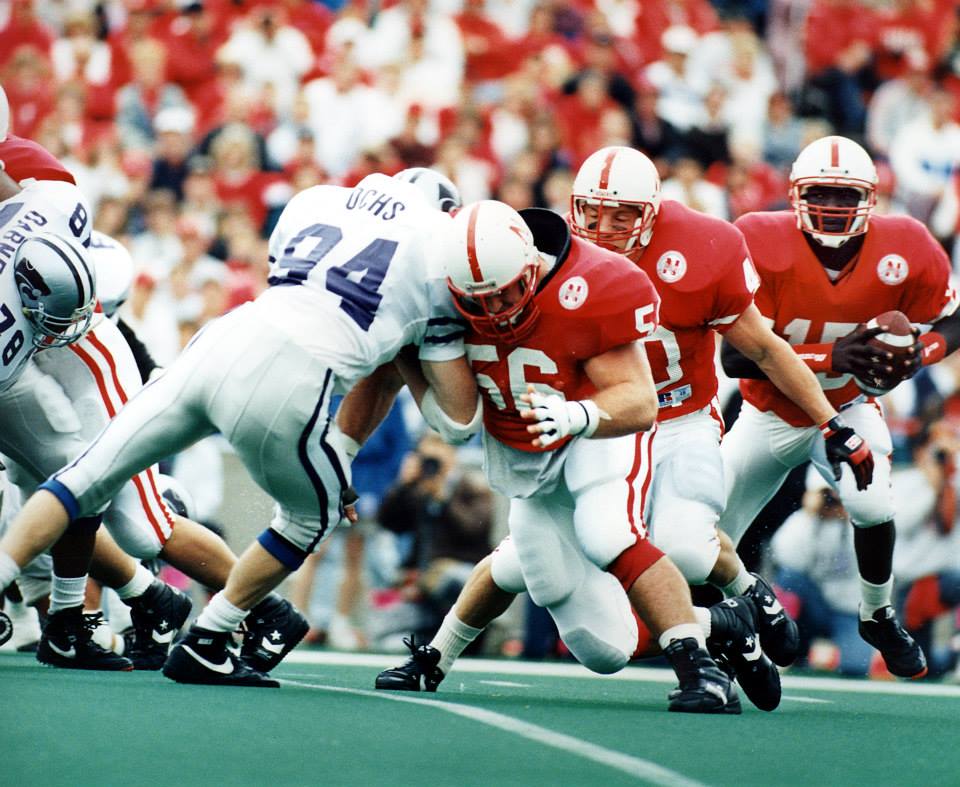
Clearing the way for Tommie
ES: Yeah, and I don’t know how well you remember that game, but that’s exactly how it went. It was miserable and cold and it was raining and we were truly one dimensional, but we got it done.
Q: That day a bunch of strength coaches were back in Lincoln moving Dave Ellis into his new house, so we saw bits of the game as it was progressing..
ES: Do you talk to Dave? I just saw him not that long ago. He’s actually doing some consulting for us nutritionally, and I saw him during training camp, believe it or not.
Q: I love Buck. He’s a great individual, isn’t he?
ES: Oh yeah, he’s a piece of work. I see him at the combine, too. Dave is a piece of work.
Q: And speaking of, was there anybody, from your perspective, behind the scenes who never quite got their due for what or how they contributed to the team? Any one specific individual stand out to you?
ES: I’ll say this, it was not just one person, but the guys in the strength program: the Bryan Baileys and the guys that really got their hands dirty with the players, those guys stood out to me as far as behind the scenes.
That part was really unique, too, the way we trained, the way we conditioned. As a matter of fact, when I was with Coach Darlington one time there was another scout there talking about how hard it was to get guys conditioned, and we looked at each other and I said, ‘Look, at Nebraska we hit the weights, we ran, we worked out at 3 o’clock, 4 o’clock in the afternoon on the turf when it was 120 degrees, and we ran all day.’ Even just the level of training and conditioning, I would definitely give a lot of credit to you guys in that area. I’m not just talking about Boyd Epley for the name’s sake, but the guys who literally worked with the players.
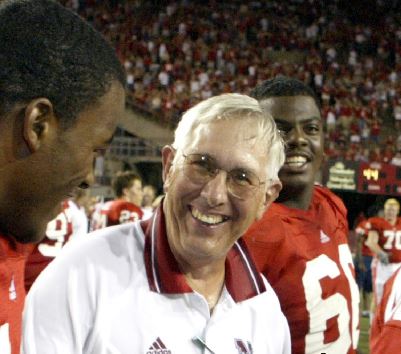
Coach George Darlington
And even just me, personally, I took advantage of the resources, and all the resources were there and it made me a player. I can’t say that if I’d went somewhere else and didn’t have those resources I would have made it to the NFL. That’s not a lock. But I went to Nebraska and I was about 175 lbs. as a freshman and I walked out of there weighing 198 and was literally 3% bodyfat and running a 4.5 forty all day. That’s not just something that happens. The resources were there and I’d give credit to those guys.
Q: Is there anything we haven’t covered that set those teams apart from others of their time?
ES: I would say this: I would say the diversity. We touched upon it a little bit, but to bring guys from across the country, from different backgrounds -be it economic or whatever, whether a guy from California or Texas or New Jersey or Florida, you look at that and the local guys- but to bring that type of diverse group and talent and bring it all together, like Trev Alberts from Iowa, and put together that type of production, that’s pretty impressive. You probably won’t see that again, when you look at the dynamics. I looked at the rosters and noticed that about 80% of the guys on Texas’ roster were from Texas, Florida only recruits Florida, so you’re not going to see that type of diversity ever again where you pull from so many different areas and you put together a product.
And I think that’s why it’s arguably one of the greatest teams -and it’s been documented- that ever played. The reason was the diversity of it. I think that’s a big reason why that was the case. If you just look at those rosters and the starters and backups and where they were from, they were from all over the place…
Q: Jersey, Chicago, you name it…
ES: Yeah, Jared Tomich was from Indiana and Jamel Williams was from Indiana. That’s pretty rare, and I don’t know if you’ll see that again. And you’ve probably seen that ESPN 30 for 30 documentary about Miami U, and those guys were all primarily from Florida, and that’s just it. That was so unique about our team, you’ll never see that again. That’s why now you’re seeing Florida and Texas and some SEC schools just dominate, because that’s where the talent base is. But Nebraska literally got the best players from a variety of different states and got them all in one spot. And it’s one thing to get the talent, but then you still have to develop the talent. And they were able to do that. It was pretty rare.
Q: How do you think we got them out of those states?
ES: That’s a good question. That part I don’t really have an answer for. Obviously, the coaches did a great job of recruiting, they were a highly motivated staff. But when you think of Lincoln, why would you want to come to Lincoln when you could go to a California school or a Texas where the weather was nice? But that was never a factor. Even when we had Tommie from Florida or Lawrence and Booker from California, but it was never a deterrent. I don’t know what brought that all together, and it’s what makes that such a unique deal.
That would be a question for one of the coaches. They may know and they may not, but I think that is really unique. And to me, especially when I’ve been around so many different schools, I see so many teams just trying to focus on their area, they really aren’t able to diversify their roster.
Q: Sure, we had guys like Luther Hardin from Illinois and Jacques Allen from Kansas City, Darin Erstad from North Dakota …
ES: Me and Luther were fraternity brothers. As a matter of fact, give him my number, will you? I don’t think he has it. And Jacques Allen, that’s an interesting story. He was basically a scout teamer, but he would basically try to kill us. He was basically a receiver, but Jacques took a great deal of pride, he was one of those guys who went all out 110%, was trying to beat you every day in practice. It didn’t matter what happened, he was going to line up and get some more. Jacques would make you lose some sleep now, and he was cocky. (laughs) For Jacques, I think in some way practice was his game day. It was his way to try to get you and beat you in whatever way it took.
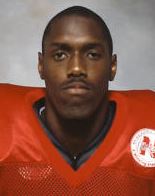
And of course, me being a DB, I would have to face Jacques. And he was kind of a leader of the scout team, too. He would make plays! He was a thorn in our side. You tell him that, he’ll get a kick out of that. He knows I’m telling the truth. (laughs) He was that guy you wanted to take out. It was, “We’re gonna nail Jacques today. He’s gonna catch one on the chin today. We aren’t gonna hear his mouth today.” And Jacques was a talker, too, (laughing) you’ll have to tell him I said that, but I mean it all in a good way. He was a good guy. In fact, his dad and my dad are kind of close together. Jacques and I aren’t really close friends, but I got to know his family and obviously competed against him every day.
Q: I hear he used to get Coach Osborne to laughing.
ES: Oh yeah, he definitely did. And Coach would appreciate it. Jacques was always a guy who was full of jokes and never took anything too seriously. I’m sure he did bring a smile to Coach Osborne. And Coach Darlington? He loved Jacques. Loved Jacques. He would say he was definitely one of the hardest-working receivers. He did. He tried to beat us and embarrass us. We didn’t take too kindly to that. (laughs)
End conversation.
Every court needs a jester, and Eric’s mention of Jacques Allen now puts the man squarely on my ‘To Contact” list. Same goes for Toby Wright, too. The group dynamic of those teams is a curiosity of sorts, for while the personality, the disposition, the life experience and the maturity level was different for each man comprising the whole, they all affected one another. In Jim Collins’ Good to Great mentioned in the intro chapter a point is made of the necessity to get the right people on the bus as well as place them in the right seats. My, how varied a seating arrangement that was. Through an oft-times eerily and ethereal instance of osmosis and symbiosis, a dynamic of synergy lived and breathed among them. And as we’ve moved along chapter by chapter, conversation by conversation, from exposition to summary, perhaps you’ve caught wind that we’re observing that the team was not made up of a few ‘stars’, per se, with faceless no-names filling in the gaps, but that it’s really a quite delicate, sometimes fragile, ever-evolving organism. Do you recall how Kevin Ramaekers put it so nicely some chapters earlier when mentioning his wanting to be like Pat Englebert, with the Peter brothers later on wanting to be like him, ad infinitum? They all rubbed off on each other in degrees both large and small. Then you have throw in the ‘Charlie McBride effect,’ too, keeping them all in line. Their world ever-changing, leadership in its many forms was required to hold the center, to keep it all from spinning out of control, with personalities and prejudices and perspectives being held in check while the collective focus never waned. Credit Tom Osborne and his staff for that.
I was slightly saddened by Eric’s prognosis that, “you’re not going to see that again anywhere, because now you have twenty-hour rules, limits on the walk-on program.” I would like to think that someone, somehow, some way, someday would read this in-depth examination and come away with a greater grasp of the era…and then repeat it. It’s been said that, “Imitation is the sincerest form of flattery.” The great 60 & 3 era deserves to be flattered in that case, and I can think of no other place to attempt it than in the very place it first occurred: Lincoln, Nebraska. Let’s be honest, a fan base as gaga as ever still resides there, the gameday atmosphere and support still exists, the national recruiting pool is just as abundant, and support staff are still maintaining an atmosphere of organizational and personal excellence. If not Nebraska, who? If not now, when? I say it’s worth the attempt. Come a runnin’ boys. Come a runnin’.
Then there was this: “Everybody wanted -deep down inside- everyone wanted to be a ‘Charlie McBride guy.’ That meant you were something. That was a hard circle to get into.” Perhaps I say this to my shame and quite possibly a descent in Tom Osborne’s stature, but from what I gather there was something of a duality of figureheads. On one hand, you had the offensive-minded, team-wide, cool, stoic and self-assured Tom Osborne, while running closely parallel to that you saw the defensive-minded fury and fearful phenomenon of Coach Charlie McBride. We haven’t heard of someone wanting to be a “Tom Osborne guy,” because it seems that was considered a given. But to be a Charlie McBride guy, well, that was a whole other ball of wax. ”McBride was all about playing for your teammates, playing for your family, you’re playing for yourself… it wasn’t about you. You were representing a lot of people when you stepped out there..” Then you throw in the national attacks of ‘95, where “we happened to have that kind of ‘us against the world’ mentality, and we’d been backed into a corner. We weren’t going to sit in the corner, we were going to come out fighting. And the only way to prove that was to come out on the field and play for the coaches, so that’s what we did. We played for Coach Osborne.” I find it very refreshing that the greatest team of all time did not necessarily play for the accolades, the future money or the aggrandizement of ego, but rather for the precious honor and the uplifting of a man and leader, Tom Osborne. It makes me proud to be a Cornhusker, for all the right reasons.
Notable quote #2:
Eric Stokes on the culture of competition: “..there was always competition. Always competition. If it came from the scout team, I mean, those guys gave it their all. It was competitive. It got heated sometimes… But that’s a big part of why we were successful, though… there was always a team, but there was always competition.”
Copyright @ 2013 Thermopylae Press. All Rights Reserved.
Photo Credits : Unknown Original Sources/Updates Welcomed